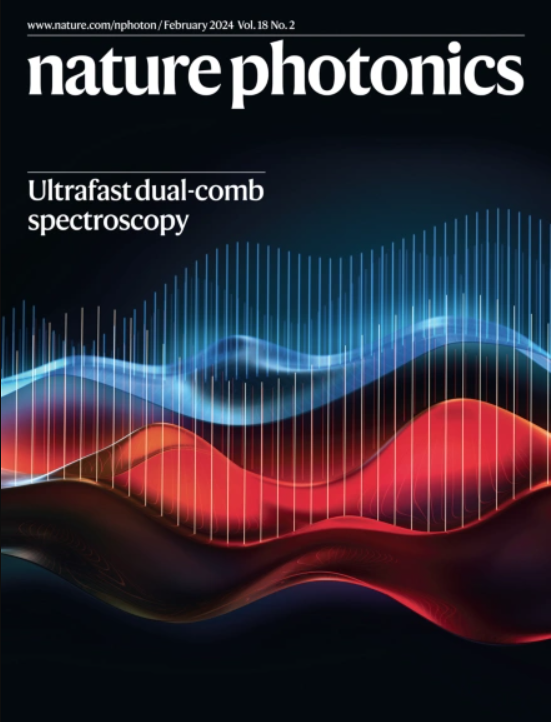无源宽带法拉第隔离器用于混合集成光子电路,无透镜和外部磁铁
IF 32.3
1区 物理与天体物理
Q1 OPTICS
引用次数: 0
摘要
基于非互反效应的光隔离对于电信、光探测和测距、甚至量子平台等高性能光子器件的正常运行至关重要。磁光法拉第旋转是最常用的非互反效应,具有宽带工作、宽输入光功率范围、低插入损耗和光隔离度高等独特优点,但目前不利于小型化。将法拉第隔离器直接集成到光子芯片中有两个主要障碍:需要笨重的外部磁铁和制造低损耗波导的挑战,这将消除对自由空间耦合光学器件的需求。在这里,我们已经解决了这两个挑战,使用一种新的飞秒激光书写技术,在锁存铋掺杂铁石榴石板的大块内创建波导,而不改变其磁光功能。因此,我们已经实现了法拉第旋转波导,其插入损耗为<;0.15 dB,优点系数为346°dB−1。通过将该法拉第旋转器插入两个30 μm厚的偏振器之间,我们进一步展示了在整个光通信c波段具有25 dB隔离比和1.5 dB插入损耗的小型化光隔离器波导,用于混合集成到没有透镜和外部磁铁的光子电路中。本文章由计算机程序翻译,如有差异,请以英文原文为准。


Passive broadband Faraday isolator for hybrid integration to photonic circuits without lens and external magnet
Optical isolation based on a non-reciprocal effect is crucial for proper operation of several high-performance photonic devices such as in telecommunications, light detection and ranging, and even quantum platforms. The magneto-optical Faraday rotation is the most commonly used non-reciprocal effect as it offers unique advantages, including broadband operation, wide input optical power range, low insertion losses and high optical isolation, but it is currently not conducive to miniaturization. Two major impediments hinder the direct integration of Faraday isolators into photonic chips: the need for bulky external magnets and the challenging fabrication of low-loss waveguides that would eliminate the need for free-space coupling optics. Here we have addressed both challenges using a new femtosecond laser writing technique to create waveguides within the bulk of latched bismuth-doped iron garnet slabs without altering its magneto-optic functionality. As a result, we have achieved a Faraday rotator waveguide exhibiting <0.15 dB insertion loss with a figure of merit of 346° dB−1. By interposing this Faraday rotator between two 30-μm-thick polarizers, we further demonstrate a miniaturized optical isolator waveguide with >25 dB isolation ratio and <1.5 dB insertion loss over the entire optical telecom C-band for hybrid integration to photonic circuits without lenses and external magnet. Using a new femtosecond laser writing technique, researchers inscribed waveguides within latched bismuth-doped iron garnet, enabling a Faraday rotator waveguide exhibiting <0.15 dB insertion loss and a figure of merit of 346° dB−1. This enabled a miniaturized optical isolator waveguide with >25 dB isolation ratio and <1.5 dB insertion loss over the entire optical telecom C-band, without lenses or an external magnet.
求助全文
通过发布文献求助,成功后即可免费获取论文全文。
去求助
来源期刊

Nature Photonics
物理-光学
CiteScore
54.20
自引率
1.70%
发文量
158
审稿时长
12 months
期刊介绍:
Nature Photonics is a monthly journal dedicated to the scientific study and application of light, known as Photonics. It publishes top-quality, peer-reviewed research across all areas of light generation, manipulation, and detection.
The journal encompasses research into the fundamental properties of light and its interactions with matter, as well as the latest developments in optoelectronic devices and emerging photonics applications. Topics covered include lasers, LEDs, imaging, detectors, optoelectronic devices, quantum optics, biophotonics, optical data storage, spectroscopy, fiber optics, solar energy, displays, terahertz technology, nonlinear optics, plasmonics, nanophotonics, and X-rays.
In addition to research papers and review articles summarizing scientific findings in optoelectronics, Nature Photonics also features News and Views pieces and research highlights. It uniquely includes articles on the business aspects of the industry, such as technology commercialization and market analysis, offering a comprehensive perspective on the field.
 求助内容:
求助内容: 应助结果提醒方式:
应助结果提醒方式:


